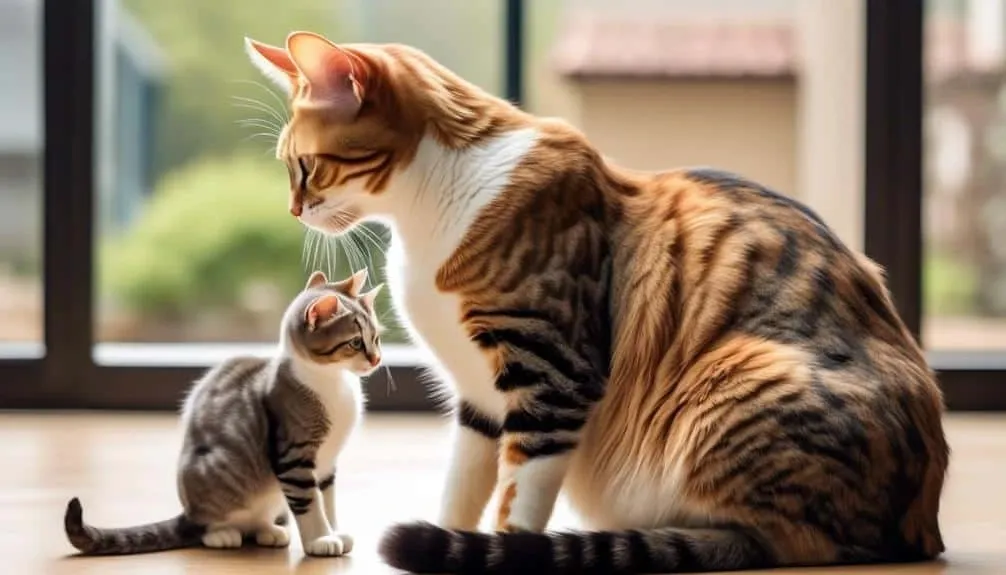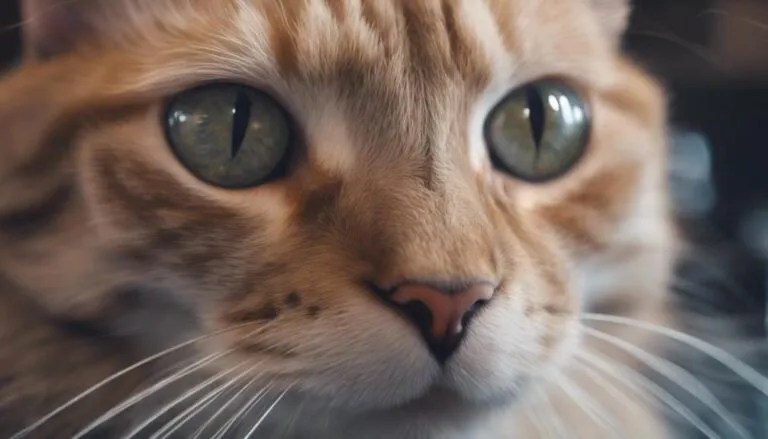The Best Fluffy Pancakes recipe you will fall in love with. Full of tips and tricks to help you make the best pancakes.

As you sit on the edge of your couch, watching your cat cautiously approach you with narrowed eyes, you can't help but wonder how you ended up in this situation. Your feline companion, once affectionate and playful, now seems distant and aloof.
It's as if a bridge has been burned, and you're left yearning for a way to rebuild the trust and connection you once shared. But fear not, for in this article, we will unravel the intricacies of mending feline bonds and mastering the art of cat apologies.
With insightful tips and expert guidance, you will soon discover the secrets to unlocking your cat's forgiveness and rekindling the bond that has been lost.
Key Takeaways
- Cats exhibit signs of offense and resentment through behaviors such as hiding, avoidance, aggression, and vocalization.
- Understanding feline body language, including tail position, ear and eye expression, and overall posture, can help determine their emotional state.
- Apologizing to a cat involves acknowledging mistakes, approaching calmly, speaking softly, offering physical affection, and engaging in interactive play to rebuild trust.
- Cats may not understand the concept of apologizing like humans do, but they may exhibit behaviors that show remorse or reconciliation, such as head bunting, rubbing against their owner, or bringing gifts. Consistency and positive reinforcement are key to mending the relationship with a cat.
Signs of Feline Resentment
If your cat is feeling resentful, they may exhibit a range of behavioral signs indicating their displeasure. Understanding cat behavior is essential in identifying these signs. Cats may hide beneath furniture to avoid interaction with their owners or react aggressively by scratching or hissing. They may also sulk or show passive behavior, vocalize distress or anxiety, or display fear through their body language.
Causes of feline resentment can include lack of attention or neglect, anxiety-filled situations like illness or vet visits, and disruptions to their environment such as moving or introducing new pets or people. Changes in routine or the removal of familiar items can also contribute to their resentment.
Reading Your Cat's Body Language
To better understand your cat's emotions and address any potential resentment, it's crucial to become adept at reading their body language. Recognizing your cat's emotions through their nonverbal cues is essential for effective communication and building a strong bond.
Cats communicate through their tails, ears, eyes, and overall posture. Observing the position and movement of their tail can indicate their mood, while the position and expression of their ears and eyes can reveal their level of comfort or agitation. Paying attention to their overall body posture and muscle tension can also provide valuable insights into their emotional state.
Understanding the importance of nonverbal communication will help you respond appropriately and address any underlying issues. By being observant and empathetic, you can strengthen your connection with your feline companion and ensure their well-being.
How to Apologize to Your Cat
When apologizing to your cat, it's important to understand and acknowledge your mistake. Cats have complex emotions, and gaining their forgiveness requires empathy and patience.
To apologize effectively, follow these steps:
- Approach your cat calmly and slowly, respecting their personal space.
- Speak softly and gently, using a soothing tone to convey your remorse.
- Offer physical affection, such as petting and stroking, to reassure your cat of your love and care.
- Engage in interactive play to rebuild trust and strengthen the bond between you and your cat.
- Be consistent in your behavior and provide positive reinforcement to show your commitment to making amends.
Understanding a cat's emotions and responding with sincerity and kindness will help mend the relationship and foster a harmonious environment.
Do Cats Apologize?
Cats, despite their inability to comprehend human concepts of apology, may exhibit behaviors that show remorse or reconciliation. Understanding feline emotions and cat behavior is key to recognizing these gestures.
While cats don't apologize in the same way humans do, they've their own unique ways of expressing remorse and trying to mend the bond with their owners. Some common behaviors include head bunting, where they gently bump their heads against you, rubbing against their owner to mark them with their scent, or even bringing gifts, such as small prey or toys.
Apologizing to a cat isn't about seeking forgiveness, but rather about rebuilding trust and strengthening the bond. Consistency, positive reinforcement, and patience are crucial in mending the relationship with your feline companion.
Timing Is Half The Work
Timing plays a crucial role in successfully apologizing to your cat and rebuilding trust. Recognizing feline anger and understanding the importance of giving cats space are key factors in the process. Here are some important points to keep in mind:
- Observe your cat for signs of anger or fear.
- Give your cat some space before approaching.
- Avoid rushing or scaring your cat further.
- Pay attention to your cat's body language and relaxation level.
- Use a soft tone and treats to make your cat feel safe and comfortable.
Approach Your Cat Carefully
Approaching your cat with caution and attentiveness is essential when trying to mend the relationship and regain their trust. Building trust and rebuilding the bond requires you to be observant and empathetic towards your cat's needs and emotions.
Before approaching, observe your cat for signs of anger or fear. Give them some space and avoid rushing or scaring them further. Pay attention to their body language and relaxation level.
Use a soft tone and treats to make them feel safe and comfortable. Stay calm and avoid sudden movements. When you approach, show your hand and let them smell you. Get down to their level, use a relaxed gaze, and engage in slow blinking.
Consistency and Positive Reinforcement
When working on rebuilding trust and strengthening the bond with your cat, consistency and positive reinforcement play a crucial role in creating a stable and secure environment for them. Here are five important points to keep in mind:
- Maintain a consistent routine: Cats thrive on routine and predictability. Establish a regular schedule for feeding, playtime, and cuddle sessions. This helps your cat feel safe and secure, knowing what to expect from their daily interactions with you.
- Reward good behavior: Positive reinforcement is an effective way to encourage desirable behavior in your cat. When they display behaviors that you appreciate, such as using the litter box or scratching on appropriate surfaces, reward them with treats, praise, or playtime. This reinforces their understanding of what behaviors are desirable and strengthens the bond between you.
- Be patient and persistent: Rebuilding trust takes time and effort. Be patient with your cat as they adjust to changes and work on rebuilding the bond with you. Consistently provide them with love, attention, and positive experiences to reinforce your commitment to them.
- Avoid punishment: Punishment can erode trust and damage the bond between you and your cat. Instead of punishing them for unwanted behavior, focus on redirecting their attention to more appropriate activities. Use positive reinforcement to encourage them to engage in behaviors that you prefer.
- Create a positive environment: Ensure that your cat's environment is enriched with toys, scratching posts, and cozy resting spots. This creates a positive and stimulating environment that helps strengthen the bond between you and your cat.
Frequently Asked Questions
Can Cats Hold Grudges Against Their Owners?
Cats can hold grudges against their owners if they feel resentful. Signs of resentment include hiding, avoiding interaction, aggression, and vocalizing distress. Rebuilding trust involves understanding their body language, apologizing calmly, offering affection, and engaging in interactive play.
What Are Some Common Mistakes That Cat Owners Make When Trying to Apologize to Their Cats?
When apologizing to your cat, avoid common mistakes such as rushing or scaring them further. Approach slowly, use a relaxed gaze, and offer treats to make them feel safe. Effective apologies require patience and understanding.
Are There Any Specific Body Language Cues That Indicate a Cat Is Accepting an Apology?
When apologizing to your cat, it's important to remember that they may not understand human body language cues. However, cats rely heavily on scent, so using familiar scents can help in accepting an apology.
How Long Does It Typically Take for a Cat to Forgive Their Owner After an Apology?
It's important to have patience when rebuilding trust with your cat after an apology. Consistency plays a vital role in strengthening the bond between you and your cat. It may take time, but don't give up.
Are There Any Alternative Methods of Apologizing to a Cat Besides Physical Affection and Interactive Play?
To apologize to your cat, try using verbal affirmations and offering treats. Cats may not understand the words, but your soothing voice can help rebuild trust. Treats show love and reinforce positive behavior.
Conclusion
In conclusion, mastering the art of cat apologies is essential for mending feline bonds and creating a harmonious relationship with your cat. By understanding their body language and recognizing signs of offense, you can effectively apologize and rebuild trust.
Remember, timing and approach are crucial, so be patient and gentle with your feline friend. With consistency and positive reinforcement, you can mend the bond with your cat, just like a gentle breeze soothes the restless sea.








